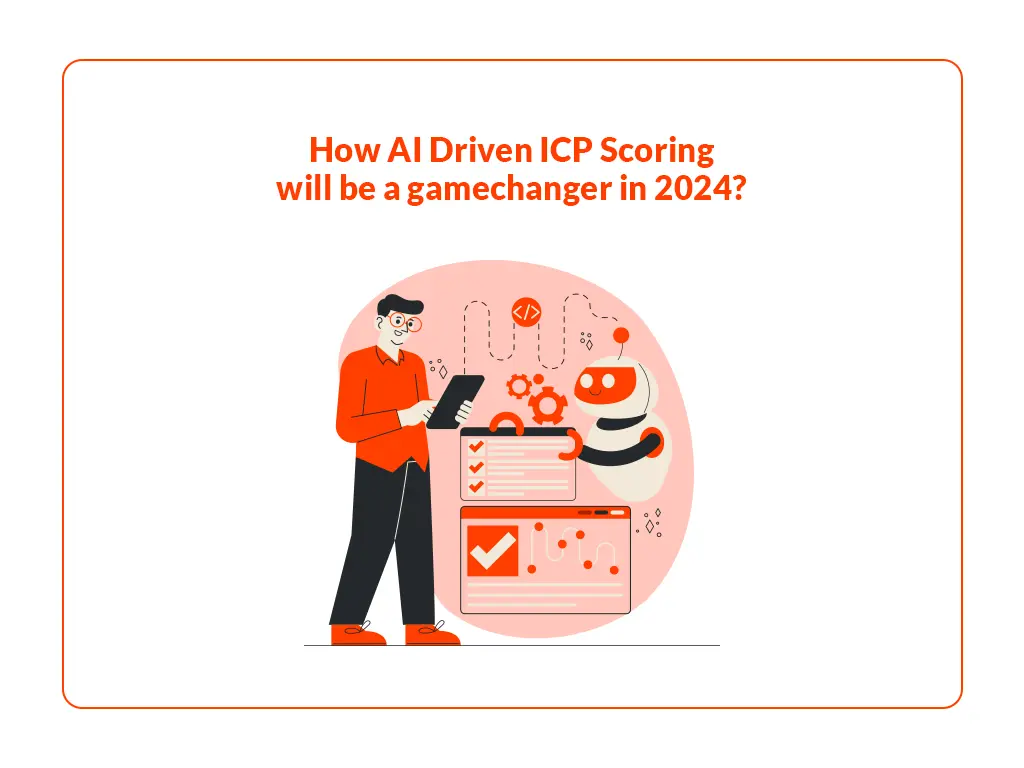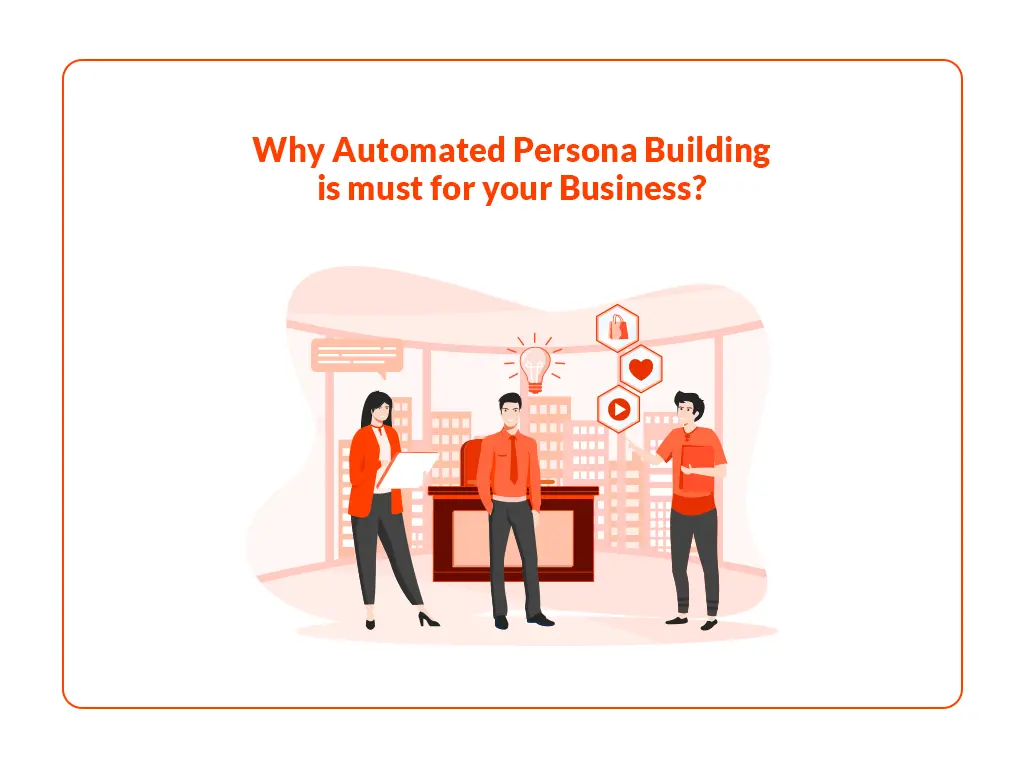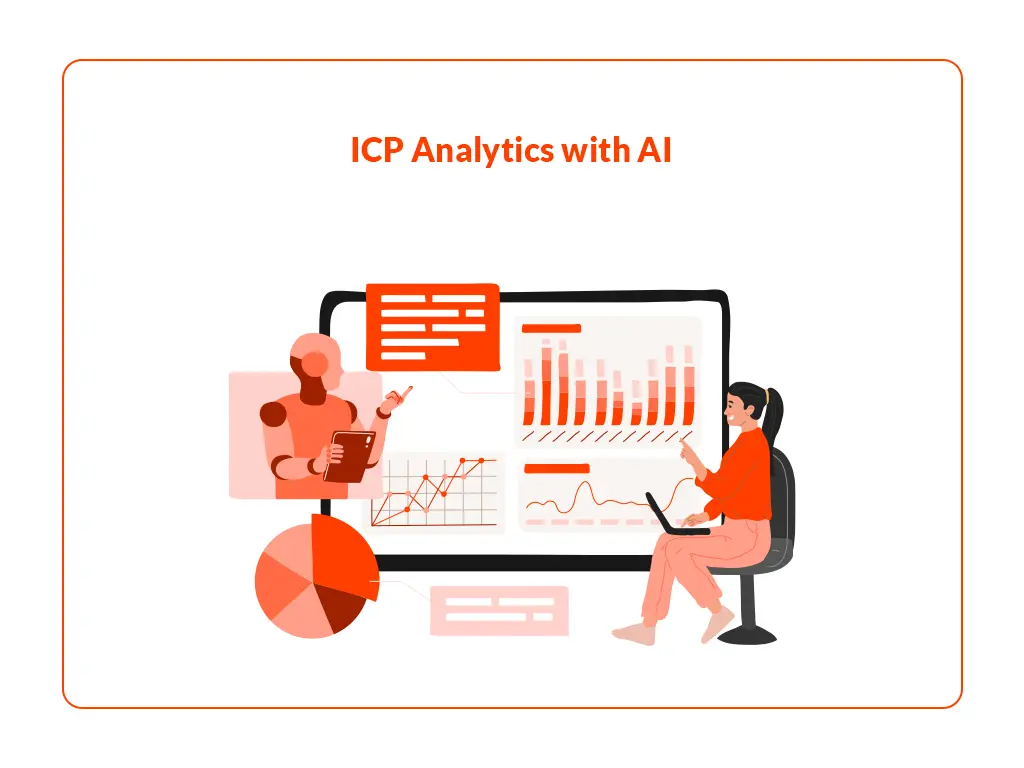What is VAIS and how is it calculated?
Valasys AI Score (VAIS) measures the alignment of an account against a product. The higher the VAIS, the more ideal the buyers are for your product.
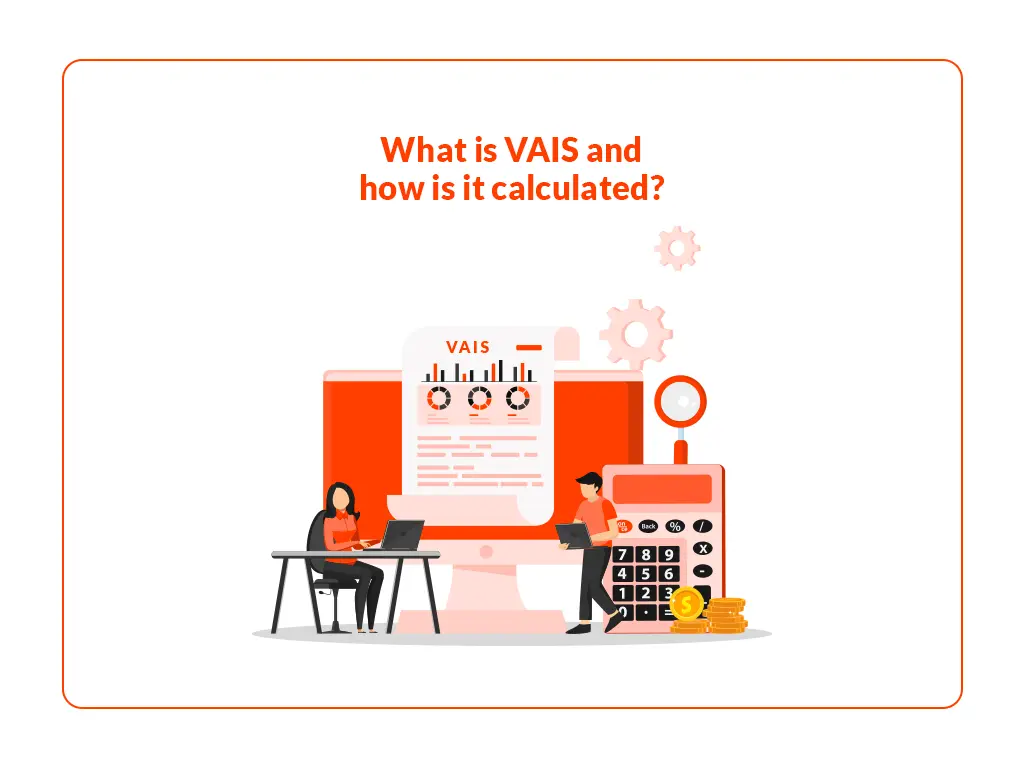
VAIS, a proprietary score, generated by Valasys Media proudly presents its first B2B SaaS-based Data Insight platform, Valasys AI. Leveraging hybrid ML models, predictive analytics, and natural language processing, Valasys AI transforms the entire sales pipeline. Right from prospecting to outreach, this data insight platform does not give you mere breadcrumbs but a roadmap that leads to better conversion.
If you are managing data, marketing, or even sales and are not able to read the insights from the data, you are pretty much blind. It’s like shooting in the dark, blindfolded. Yes, it is that bad. And you will end up questioning the quality of the lead but not your approach.
Why? Because of confirmation bias. Preexisting beliefs that lead you to believe you are always right and the quality of leads is poor.
But what if, I tell you, the way you are prospecting the leads or the way you are not personalizing the outreach is wrong? How do I say that? Based on our market research & survey data and the statistical analysis we ran, the model produced results that baffled us.
To overcome these biases and ensure you’re targeting the right accounts, Valasys AI uses its proprietary VAIS evaluation system.
What if I told you that no lead is inherently bad? It may simply be a matter of optimizing how it is utilized.
As the model kept on factoring increasingly new parameters, the insights revealed patterns we hadn’t anticipated, challenging our preconceived notions about buyer behavior, trigger identifications, time of outreach, and personalization techniques of outreach communications.
VAIS challenges the status quo of how one identifies the best buyers. But that’s just scraping the surface of this multi-layered data insight platform. The double score layers of VAIS+Intent are designed to help you identify your best buyer persona for prospecting and then create a buyer journey using the scores for nurturing & outreach. Let’s reveal some of the fascinating workings of Valasys AI.
What is VAIS?
VAIS is a multi-dimensional evaluation of an account against a product. It essentially measures the alignment of the account with the product. For a chosen product, how strongly does a domain align? This score identifies the ideal buyers for your product. The higher the VAIS, the higher the alignment and the affinity towards your product/service.
As the owner of a software product, Valasys AI will help generate an ABM list. The ABM list will be prioritized according to the VAIS, meaning the accounts with the highest VAIS will be at the top. This way, we are not giving you a random list of accounts but a prioritized and segmented list. This way, you will know whom to target first.
If you look at all the other contemporary B2B tools, they are designed to give you access to data. But they do not tell you what the data mean. What is the trend? Is there any pattern you should be wary of? At which stage are the leads? Are they at the buying stage? Are they even a good fit for your product?
These tools will simply give out a list of accounts for you to guess and make random selections. But imagine getting a list where you know whom to target first with a quantifiable & measurable value.
VAIS breaks away from the traditional qualitative approach of classifying the leads but rather provides a quantitative methodology with absolute scores. This AI-generated score is then translated to all the features. Be it verifying the accuracy of your existing ABM, creating a brand-new ABM, or generating similar accounts replicating your top clients, VAIS is the basis of scoring, prioritizing & segmenting.
But why is VAIS so essential for you to make those data-driven decisions? Why does VAIS make insights actionable? Let us find out.
Why do you need VAIS?
There is a lot of data all around us today. No matter the size and scale of the entities, everyone has access to data. First-party data, 3rd party data, and even data bought from other vendors. There is no dearth of data in this decade. That is why our primary aim is not to supplement data, something you already have a lot of options to acquire from but rather the insights out of those data.
We can give you millions & millions of data. But what is the point if you have no cues to gauge their buyer journey, purchase readiness, and relevance? For way too long now, B2B outreach has been a guesswork. And so, it remains with all the contemporary tools & software. This is exactly what we as Valasys are trying to change.
We want prospecting to be a data-driven approach so that there is no room for guesswork. By calculating the numerical values and assigning the domains a score, you can quantify your “guestimations” with better precision.
Moreover, VAIS paints a complete user journey in conjunction with Bombora’s Intent signal. Without such insight, we end up wasting prospecting and nurturing points of contact only to find out that they are not aligned with our product, do not have an immediate need, or are entirely misaligned. Imagine the frustration of the sales rep who after hours of cherry-picking ends up knocking on the wrong door.
And now with the rise of LLMs and predictive analytics, interpreting the insights and translating them into actionable follow-ups with AI is a significant change. This complex modeling system takes into account the market trends, product performance, reviews from account owners, and other parameters to effectively monitor the variations that can affect the VAIS.
This makes it immensely dynamic and up-to-date to ensure you have access to live statuses of the product, their viability, and the kind of businesses they have affinity towards.
But most importantly, the factors and the parameters that went into generating the VAIS, make it integral to mapping the buyer journey. The next section deals with the scoring logic.
How is VAIS calculated?
By now, you know what VAIS is and why we need this score for sales enablement and mapping the buyer journey. In this section, let us understand how the score is generated, what factors play a part in generating the score, and how to source the parameters and create the framework to fine-tune the score.
To calculate VAIS, the factors are grouped into two categories. The product factors & the accounts-related firmographic details.
1. Product-Related Parameters
Our market research team has reviewed over 45,000+ software & tools on G2 & Capterra. Additionally, surveys and questionnaires were sent out to the product owners to ensure we capture subtle nuances that influence the buying and selling of the product. The following parameters are quantified through reviews, surveys, and research reports:
- Demand for the Product: How popular is the product in the market? What is the current demand, and how is it trending?
- Competitive Landscape: How competitive is the market for this product? Who are the major players?
- Relevant Industries of the Product: Which industries find this product most applicable and beneficial?
- Success Stories of the Product: What are the key case studies or success stories demonstrating the product’s effectiveness?
- Revenue Potential of the Product: What is the potential for revenue growth from this product based on current and projected market conditions?
- Market Share of the Product: What is the product’s current share in its respective market or industry?
- Market Penetration of the Product: How deeply has the product penetrated its target market segments?
There are a host of other product-related parameters that were factored in for calculating the VAIS.
2. Company Firmographics Related Parameters:
Simultaneously, similar surveys, questionnaires, and reviews have been conducted with decision-makers of the accounts who participate in the buying process. This is done to understand their psyche & what influences them eventually to buy or walk away from the product. For these, some of the parameters considered are:
- Company Size: Number of employees and overall organizational scale.
- Company Revenue: Annual revenue to assess purchasing power and budget allocation.
- Company Industry & Sub-Industry: The specific industries and sub-industries the company operates in & can impact their needs and purchasing behavior.
- Affordability: The company’s budget constraints and ability to afford the product or service.
- Existing Install-based: The current software or systems the company uses, which could influence their decision to switch or adopt new solutions.
- Industry-Specific Rules: Rules and regulations particular to the industry that might affect the buying process.
- Purchasing Triggers & Windows: Key factors and timeframes that prompt a company to consider making a purchase, such as fiscal cycles or operational needs.
Each of the factors is then assigned weights based on their importance in the buying decision. After that, the weighted average method is used, and an absolute percentile is created to ensure there is no bias in the evaluation process. This method allows for a more objective comparison of the options available, providing a fair and balanced result called the VAIS.
While the intricacies of VAIS remain a closely guarded trade secret, its precision in identifying buyer alignment sets it apart from other B2B tools.
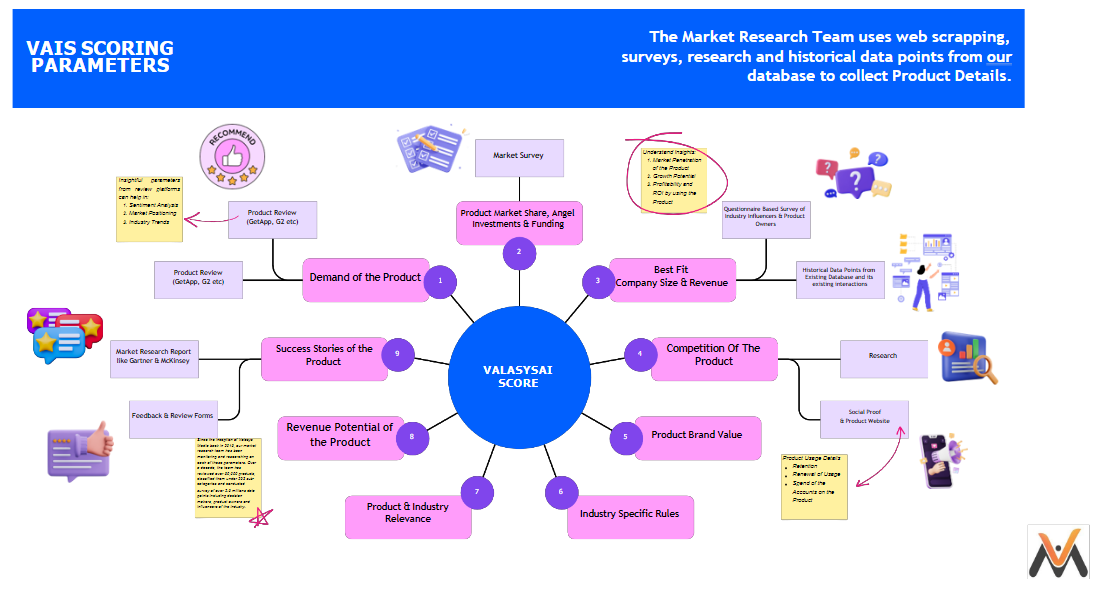
How does Intent combine with VAIS?
VAIS is only the first step towards the buyer journey. In its essence, VAIS identifies the ideal buyers. The higher the score, the better the buyer for your product. So, with VAIS, you know who your ideal buyers are.
But now that you know your buyers, it is important to gauge the purchase readiness of your buyers. Why? Because then accordingly, you can create the buyer journey and map the user at the relevant stages of the funnel.
And that is where the intent signal comes in. Our partnership with Bombora means you can get access to these insights that will help you visualize the buyer journey. And that’s not all. With Bombora, you can tap into the topic’s domains are showing intent for. You can use this information strategically to personalize your outreach communications.
Over 4 million+ weekly intents are generated for domains and are updated every week. You can track the trend of the topics against a domain. This way, say, if the interest in the topic for a domain peaks, you can push more content along the same lines or retract if the trend drops.
This combination of VAIS + Intent creates a complete buyer journey. Something that can help you create full-funnel strategies, aid your programmatic ad campaigns as a data management platform, or even work as a sales enablement platform.
Here’s a complete interpretation chart:
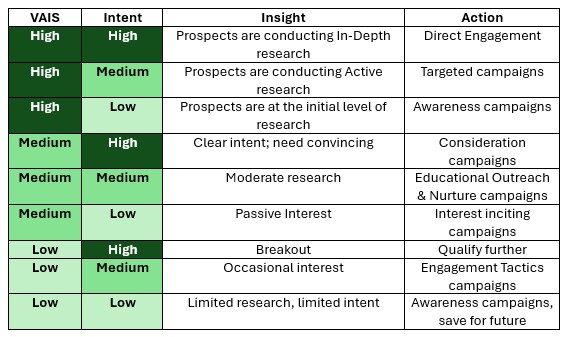
To learn more about Valasy AI, visit here. Schedule a demo to see the tool live in action, here. Experience firsthand how Valasys AI’s data insights can revolutionize your sales funnel.

